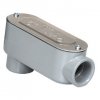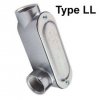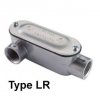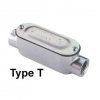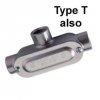Yep. a sketch would help. Until then my imagination is running wild: I'm envisioning you coming through a concrete or cement-block foundation with RSC or IMC into a LB conduit body (as in the image below) to get the 90 degree turn you need and still keeping the conduit flush to the side of the building for its vertical or horizontal run. The door to the LB would have its furnished screws replaced with a tamperproof fastener as found ==>
here <== . You could even use these special-headed bolts to secure the IMC to building with single-hole conduit straps. I would avoid the Torx with pin because you can buy bits to fit those at any Home Depot or Harbor Freight. I recall 30 years ago that was not the case when I sought to secure the pedestrian pushbutton signs ('Push button, wait for walk signal') on traffic signal poles and the tool to fit the Torx with pin was sold only by the manufacturer of the fastener.
I know this may be the farthest from YOUR plan so give us a sketch.
View attachment 22066

